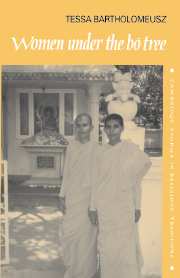Book contents
- Frontmatter
- Contents
- Preface
- Acknowledgments
- Notes on pronunciation
- Dramatis personae
- PART I
- PART II
- 5 The institutionalization of tradition: the early twentieth century and the lay nun
- 6 The lay nun in transitional Ceylon
- 7 The dasa sil mātā in contemporary Sri Lanka
- 8 Novitiates, western lay nuns, and cave dwellers
- 9 The Sri Lankan Bhikkhuī Saňgha: trends and reflections
- Epilogue: Women under the Bō tree
- Appendices
- Notes
- Select bibliographies
- Index and glossary
5 - The institutionalization of tradition: the early twentieth century and the lay nun
Published online by Cambridge University Press: 05 November 2011
- Frontmatter
- Contents
- Preface
- Acknowledgments
- Notes on pronunciation
- Dramatis personae
- PART I
- PART II
- 5 The institutionalization of tradition: the early twentieth century and the lay nun
- 6 The lay nun in transitional Ceylon
- 7 The dasa sil mātā in contemporary Sri Lanka
- 8 Novitiates, western lay nuns, and cave dwellers
- 9 The Sri Lankan Bhikkhuī Saňgha: trends and reflections
- Epilogue: Women under the Bō tree
- Appendices
- Notes
- Select bibliographies
- Index and glossary
Summary
INTRODUCTION
In the decades that followed the Countess's tenure in Ceylon, Ceylon Buddhists continued to provide women with a place in which they could renounce lay life. As projects to re-establish the tradition of female renunciation increased in the early decades of the twentieth century, the vocation of women who had renounced their lay identity became institutionalized, perhaps after a hiatus of several hundred years. In this chapter, I explore traditional notions of the pious laywoman, notions that have shaped the vocation of the lay nun, and draw a contrast with older patterns of thought concerning the laity. I hope to build a picture of the changes that have superseded traditional ideas about gender, on the one hand, and the laity, on the other. In chapters 3 and 4, I showed how Buddhists from other cultures, including Europeans and Southeast Asians, transformed late nineteenth-century Buddhism in Ceylon. In this chapter, I describe a project that was intended to resuscitate Buddhism by elevating women and providing them with a place to renounce. The project was the brain child solely of Ceylon Buddhists; however, British sympathizers called attention to the project, thus popularizing it, while Burmese Buddhists provided the guidelines for the project, which today is the most well-known upāsikārāmaya in the island.
Though, as we saw in chapter 3, the Saňghamittā Upāsikārāmaya was a response to the specific changing social situation of late nineteenth-century Ceylon, Ceylon Buddhists, such as Dharmapāla, often invoked the Burmese lay nuns' example. Moreover, Burmese lay nuns were highly visible in Ceylon at that time; their example doubtless influenced the changing role of Buddhist women in the island.
- Type
- Chapter
- Information
- Women under the Bo TreeBuddhist nuns in Sri Lanka, pp. 91 - 108Publisher: Cambridge University PressPrint publication year: 1994



